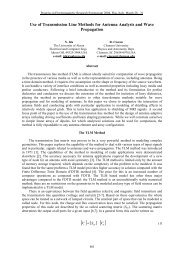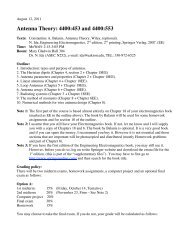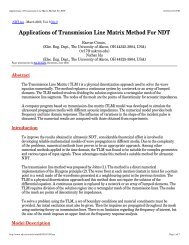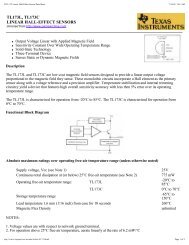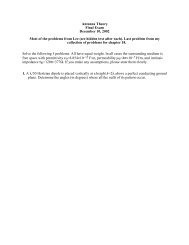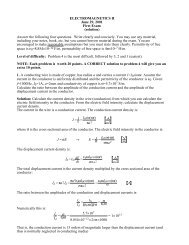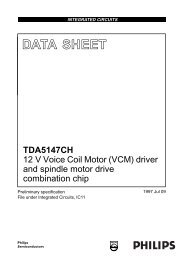Time domain surface impedance concept for low frequency ...
Time domain surface impedance concept for low frequency ...
Time domain surface impedance concept for low frequency ...
Create successful ePaper yourself
Turn your PDF publications into a flip-book with our unique Google optimized e-Paper software.
d, respectively. The two co-ordinate systems are related as<br />
fol<strong>low</strong>s:<br />
x 1 ¼ d 1 a 1 ; x 2 ¼ d 2 a 2 ð13Þ<br />
Equations (9)–(11) with the co-ordinates in (13) are written<br />
in the <strong>for</strong>m<br />
@H xk<br />
X 2<br />
@Z<br />
i¼1<br />
@E xk<br />
@Z<br />
X 2<br />
i¼1<br />
d k<br />
d k<br />
@H Z<br />
Z @x k<br />
@H xi<br />
H xk<br />
d k Z ¼ð 1Þ3 k sE x3 k<br />
; k ¼ 1; 2;<br />
ð 1Þ i d 3 i<br />
¼ sE Z<br />
d 3 i Z @x 3 i<br />
ð14Þ<br />
d k<br />
d k<br />
@E Z<br />
Z @x k<br />
E xk<br />
d k Z ¼ð @H 1Þk x3<br />
m k<br />
1 ; k ¼ 1; 2;<br />
@t<br />
@E xi<br />
ð 1Þ 3 i d 3 i<br />
d 3 i Z @x 3<br />
@H Z<br />
@Z þ X2<br />
d<br />
i¼1 i<br />
d i<br />
@H Z<br />
¼ m 1<br />
i @t<br />
@H xi<br />
X 2<br />
¼ H Z<br />
Z @x i i¼1<br />
4 Dimensionless variables<br />
d i<br />
ð15Þ<br />
ð ZÞ 1 ð16Þ<br />
Fol<strong>low</strong>ing perturbation theory methods, we introduce the<br />
characteristic scale factors <strong>for</strong> the variables of the problem.<br />
The choice of the scale factors <strong>for</strong> co-ordinates x 1 ; x 2 ; Z is<br />
evident, namely the characteristic size D ¼ minðd 1 ; d 2 Þ of<br />
the conductor’s <strong>surface</strong> <strong>for</strong> x 1 and x 2 , and the penetration<br />
depth d <strong>for</strong> Z. The quantity t was introduced in (8) as the<br />
ratio 2/o in the case of time-harmonic fields or the incident<br />
pulse duration in the case of transient sources and is<br />
there<strong>for</strong>e the natural scale factor <strong>for</strong> time. We denote <strong>for</strong><br />
now the scale factors <strong>for</strong> the electric and magnetic fields as<br />
E and H , respectively.<br />
Let us now switch to the fol<strong>low</strong>ing non-dimensional<br />
variables:<br />
~x k ¼ x k =D; ~t ¼ t=t; ~Z ¼ Z=d; ~E ¼ E=E ; ~H<br />
¼ H=H <br />
ð17Þ<br />
Here and be<strong>low</strong>, the sign ‘B’ denotes non-dimensional<br />
quantities.<br />
Substitution of (17) into (14)–(16) gives<br />
H <br />
d<br />
<br />
@ ~H xk<br />
@~Z<br />
d<br />
D<br />
d k<br />
d k<br />
@ ~H Z<br />
d~Z @ ~ x k<br />
¼ ð 1Þ 3 k E s~E x3 k<br />
; k ¼ 1; 2<br />
d k<br />
~H xk<br />
d~Z<br />
<br />
ð18aÞ<br />
H X 2<br />
ð 1Þ i d 3 i @ ~H xi<br />
D d<br />
i¼1 3 i d~Z @ ~ ¼ sE ~E Z ð18bÞ<br />
x 3 i<br />
E <br />
<br />
D @~E xk d k @~E Z<br />
~E xk<br />
D d @~Z d k d~Z @ ~ x k<br />
d k d~Z<br />
ð19aÞ<br />
¼ ð 1<br />
Þ k H @ ~H x3<br />
m 1<br />
t @~t<br />
k<br />
; k ¼ 1; 2<br />
E X 2<br />
ð 1Þ 3 i d 3 i @~E xi H @ ~H Z<br />
D<br />
d<br />
i¼1<br />
3 i d~Z @ ~ ¼ m 1<br />
x 3 i<br />
t @~t<br />
D @ ~H Z<br />
d @~Z þ X2<br />
i¼1<br />
d i<br />
d i<br />
@ ~H xi<br />
X<br />
d~Z @ ~ ¼ D ~H 2<br />
Z<br />
x i i¼1<br />
d i<br />
ð19bÞ<br />
ð d~Z Þ 1 ð20Þ<br />
Note that not all scale factors in (18)–(20) are actually<br />
independent. Indeed, from (8) it fol<strong>low</strong>s that<br />
p<br />
d ¼<br />
ffiffiffiffiffiffiffiffiffiffiffiffiffiffiffiffi qffiffiffiffiffiffiffiffiffiffiffiffiffiffiffiffiffiffiffiffiffi<br />
t=ðsm 1 Þ ¼ t=ðsm 1 D 2 ÞD ¼ pD;<br />
qffiffiffiffiffiffiffiffiffiffiffiffiffiffiffiffiffiffiffiffiffi<br />
ð21Þ<br />
p ¼ d=D ¼ t=ðsm 1 D 2 Þ 1<br />
where the parameter p is proportional to the ratio of the<br />
penetration depth and characteristic size of the conductor’s<br />
<strong>surface</strong>. The relation between E and H fol<strong>low</strong>s from (19):<br />
E ¼ m 1D<br />
t H ð22Þ<br />
There<strong>for</strong>e, the total number of basic scale factors is 3, <strong>for</strong><br />
example: t, D and H . The practical selection of the scale<br />
factors should be based on the input data of a given<br />
problem [21]. Sometimes the total current is used as input<br />
data. In such cases it is natural to use the characteristic<br />
current I as one of the basic scale factors instead of E or<br />
H . The relation between I and H can be obtained using<br />
the Biot-Savart law<br />
Z<br />
~H ¼ ð4pÞ 1 ~I ~R=R 3 dl ð23Þ<br />
L<br />
Transfer to the non-dimensional variables in (23) gives:<br />
Z <br />
~~HH ¼ I ð4pDÞ 1 ~~I ~ <br />
~R=~R 3 d ~ l ð24Þ<br />
L<br />
Thus<br />
H ¼ I = ð4pD Þ ð25Þ<br />
Substitution of (21)–(22) into (18)–(19) gives<br />
p @ ~H xk<br />
@~Z<br />
p 2 X2<br />
i¼1<br />
@~E xk<br />
@~Z<br />
p 2 X2<br />
i¼1<br />
p 2 ~H xk<br />
~d k p~Z<br />
p 2 dk ~ @ ~H Z<br />
~d k p~Z @ ~ ¼ð 1Þ 3 k ~E x3 k<br />
; k ¼ 1; 2;<br />
x k<br />
~<br />
ð 1Þ i d3 i @ ~H xi<br />
~d 3 i ~Z @ ~ ¼ ~E Z<br />
x 3 i<br />
ð26Þ<br />
p~E xk<br />
~d k p~Z<br />
p d ~ k @~E Z<br />
~d k p~Z @ ~ ¼ð 1Þ k p @ ~H x3<br />
x k<br />
@~t<br />
~<br />
ð 1Þ 3 i d3 i @~E xi<br />
~d 3 i ~Z @ ~ ¼ @ ~H Z<br />
x 3 i<br />
@t<br />
@ ~H Z<br />
@~Z<br />
p ~H Z<br />
X 2<br />
i¼1<br />
1<br />
~d i p~Z ¼ p X2<br />
i¼1<br />
~d i @ ~H xi<br />
~d i p~Z @ ~ x i<br />
k<br />
; k ¼ 1; 2;<br />
ð27Þ<br />
ð28Þ<br />
where ~ d k ¼ d k =D; k ¼ 1; 2. Equations (26)–(28) do not<br />
contain the scale factors <strong>for</strong> the electric and magnetic fields<br />
anymore. The remaining scale factors <strong>for</strong> the co-ordinates<br />
are included only in the <strong>for</strong>m of the ratio d/D which is the<br />
small parameter of the problem.<br />
5 Expansions in the small parameter<br />
We now apply Laplace’s trans<strong>for</strong>m fol<strong>low</strong>ing the rule<br />
ef ðesÞ ¼ R 1<br />
0<br />
ef ðetÞ expð esetÞdet. Here f denotes an arbitrary<br />
function. In the Laplace-<strong>domain</strong>, (26)–(28) are written<br />
178 IEE Proc.-Sci. Meas. Technol., Vol. 152, No. 4, July 2005



